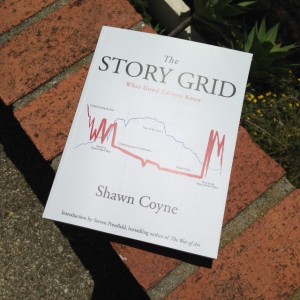Files I Work With, #3

We’ve been talking over the past couple of weeks about the five files I have on-screen when I’m working on any project—fiction or non-fiction—and how the use of these files dovetails with the principles Shawn puts forward in his new book, The Story Grid. The files are my idiosyncratic way of applying Shawn’s universal principles.

The principles of storytelling are universal. You and I as writers will apply them in our own demented ways.
To refresh our memory:
1. The actual working file of the story.
2. Conventions of the Genre.
3. Scene by Scene.
4. MissingMissingMissing.
5. Culls
So far we’ve talked about Conventions of the Genre and MissingMisssingMissing. Today let’s turn to Scene by Scene.
In The Story Grid, Shawn analyzes Thomas Harris’ classic thriller, The Silence of the Lambs. He breaks the novel down into sixty scenes.
That’s exactly what I do.
The project I’m working on now has 52 chapters, i.e. the equivalent of scenes. My file, Scene by Scene, lists them all, with a short paragraph or two describing what happens in each scene.
The file is 20 pages long, single-spaced.
Why do I do this? What purpose does this file serve?
First, it helps me see the story globally, to get a sense of its flow and its rhythm. The actual working file of the story (#1 above) is 200 pages long, single-spaced. Way too long to get a bird’s-eye view of.
Scene by Scene is compact enough, while still containing all critical story elements, that I can read it in a few minutes and get a real sense of the shape and contour of the story.
Here’s what I ask myself as I read the file over (and this is straight out of Shawn’s concept of the Story Grid):
1. Does the story break down into recognizable “acts?” How many? Three? Four? Five? Do the sections work together? Do they flow? Are they each the right length?
If I were designing a car this way, I would be asking questions like:
Is there an engine? Do we have four wheels? Is there a place for the driver to sit? Is there a transmission? A suspension? Is the vehicle balanced end-to-end and side-to-side? Does it have power? Does it look good?
In a way, the Scene by Scene file serves the same purpose as the one-page “Foolscap.” It’s short enough to give me the 30,000-foot view of the story. The difference between it and the Foolscap is obviously that it’s much more detailed—but not so over-detailed that it overwhelms me and bogs me down in details.

In the Foolscap Method, we boil the story down to one page. In Scene-by-Scene, it may take 20 pages.
2. The second thing I use Scene by Scene for also comes straight out of The Story Grid.
I ask myself as I read from Scene 1 to Scene 52, “Is the drama escalating? Is the jeopardy to our characters increasing? Are the stakes getting higher?
“Are we hooking the reader? Are we doling out our narrative goodies at the proper rate? Too much too soon, so the reader gets overwhelmed? Not enough and too slowly, so she gets bored?”
In the story I’m working on now, one thread is a developing bond between two characters. To test this, I’ll read through the Scene by Scene file looking for nothing but these “growing bond” beats.
I’ll ask myself, “Is the friendship-bond escalating? What specific story beats show this? Are the two characters closer in Scene 23 than they were in Scene 17? Are they closer in Scene 47 than in Scene 31? Does their bond reach its highest level in the final scene?”
True, this could be done by reading the Big File, the actual book. But that would take forever and, for sure, I’d get sidetracked by other issues that would inevitably crop up.
Scene by Scene keeps it lean and simple.
Next question: What goes into each paragraph in Scene by Scene? What do we leave in and what do we leave out?
I’m looking always for story threads (more about this in next week’s post). What I mean by that is “strings” or “lines” that run through the global story, e.g. the “growing friendship” string cited a couple of paragraphs above.
Here’s part of one Scene by Scene scene from the book I’m working on now. The details will be incomprehensible, I know, but I hope the gist will show through.
29. TOXIC SLUDGE
Mika reveals that sludge is toxic waste — and human bones in it. ESCALATION of LINE #6. She wants to go to the police. Mika also shows S the JIMMY BRESLIN ARTICLE in the paper, which contains more backstory re B, i.e. LINE #4.
Breslin article prompts S to speculate on who planted it, who made it happen, and why now? LINE #6 and LINE #4. That fact alone that somebody made this happen at this point shows that the stakes of LINE #6 are continuing to escalate. Now they’ve gone public. They’re in the newspaper.
“LINES” is my own shorthand for story threads. I want to identify the beats in these threads in every scene in which they appear, so I know they’re there. So I know I’ve got ’em. If I don’t, I’ll have to address that and fix it. And I want to be certain these beats are escalating from scene to scene. Again, I’ll get into more detail on this in next week’s post.
The point is that the Scene by Scene file helps me keep track of the multiple story threads that are moving through the greater narrative. Narrative drive dies if these threads are not constantly evolving and growing, becoming more interesting, and if the stakes involved are not getting greater.
One final very important point. The story, as we’re writing it, is not being constructed formulaically to adhere to these tests or checkpoints. The story comes by instinct, in the Muse-driven rush of the first draft, just from pure storytelling impulse, intuition, and inspiration. (Of course if we’re smart, we’ll have thought it all through in advance—but not to the point of self-paralysis.)
It’s only later, in this editing/analysis stage, that we put the microscope on it. To return to the car-building analogy, the story gets put together the same way we’d construct a hot rod in our garage.
Set up the frame.
Stick in the engine.
The transmission goes here.
Etc.
It’s only once our crazy-looking jalopy is sitting there under the lights that we stop, catch our breath, and ask ourselves, “Hmm, do we really want rear-wheel drive? Don’t we need more weight over the front tires?” And so forth.
The moral of this post is that the editing/story analysis concepts that Shawn has delineated so powerfully in The Story Grid are put into practice idiosyncratically (and often instinctively and unconsciously) by the individual writer. What Shawn calls “story value,” you or I may call “emotion” or “meatball.”
We’re each building our car our own way. But the universal principles apply always—and you and I need to know them as well as Enzo Ferarri knows how to put together a racing machine.
We need an engine.
We need a way to get power to the wheels.
We gotta have a place for the driver.
More on this subject next week.




This series is incredibly helpful – thanks so much!
Do you create this scene by scene file before or after you have drafted the story? It sounds like a tool you use in revision, but would appreciate if you could clarify. Thanks!
Excellent question, Glenda. Yes, I do a version of the Scene by Scene file BEFORE starting. But I keep it rough and try not to hold myself too tightly to it as I blast through the first draft, just so I don’t self-censor. I’m hoping for happy accidents in the first draft.
Thanks. That makes perfect sense.
If I understand correctly, the process is Foolscap, First Draft, Five Files. If so, that means you write the Scene-by-Scene as a first stage of revision. That is, before getting into the deep editing, you’ve got this file pretty much done. From that you can create MissingMissingMissing, etc.
Is this about right?
Not quite, David. Sorry I’m being so confusing. I do a Foolscap and a Scene by Scene BEFORE the first draft, then do a second, much more detailed Scene by Scene after the first draft. The point of both is the same: to give my a compact document that I can skim easily to get a sense of the shape and contour of the piece.
That makes sense. The first Scene-by-Scene is a like a general outline, and the post-First Draft one is a detailed review of what should be in the story. That must help a lot with the revisions. Thanks.
Thank you for having the same question I did, David. As you said, that process seems like a huge help in editing.
Ultimately, every artist has to find his or her own process that works. But I very much appreciate you sharing yours and will definitely be picking up a few of these ideas. Tracking the events in my novel and culling inconsistencies are probably my biggest issues.
Interesting… It sounds a bit like how I construct an engineering report:
1) Figure out the type of report (genre)
2) High-level outline based on the genre
3). What tables and graphs do I need in order to guide the reader to the final conclusion
4). Block in the text
5). Refine the above steps over and over as I flesh out the document and troubleshoot … Keeping a few files of missing things, culls, ideas, problems, questions about the conventions of the genre…
Piece of cake, Christine!
This would be a great tool for turning the book into a screenplay.
I am working on my second draft of my novel and this book and series couldn’t have some at the right time. I love hearing how a pro creates. Very very helpful thank you Steven.
UR THE BEST!!!